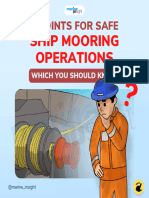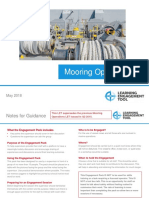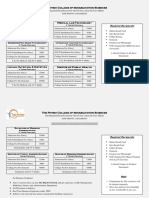LET 2020 Q1 Dry Docking
LET 2020 Q1 Dry Docking
Uploaded by
tvinhnguyenCopyright:
Available Formats
LET 2020 Q1 Dry Docking
LET 2020 Q1 Dry Docking
Uploaded by
tvinhnguyenOriginal Description:
Copyright
Available Formats
Share this document
Did you find this document useful?
Is this content inappropriate?
Copyright:
Available Formats
LET 2020 Q1 Dry Docking
LET 2020 Q1 Dry Docking
Uploaded by
tvinhnguyenCopyright:
Available Formats
Dry Docking
Notes for Guidance
What the Engagement Pack includes Who is to be Engaged?
• Key points the supervisor should cover in their discussion For the use of vessel crews and all those who are involved in
• Questions the supervisor can ask the group marine operations.
• Risk Level icons to allow the supervisor to label risk situations
Where?
Purpose of the Engagement Pack Engagement should be carried out in a quiet room/area where
To help supervisors provide their staff with a platform to have a they will not be disturbed. The vessel’s office, mess room, or quiet
meaningful safety discussion and encourage sharing of area in a workshop would be suitable.
experiences and discussions around their learning outcomes.
When to hold the Engagement
Using the Engagement Pack Choose a time that is suitable for all staff. This should be when
This pack has been designed for use by a supervisor in front of a they are alert and most likely to contribute to the discussion. This
group of no more than 10 people. The pack should be placed on a will help in absorbing and retaining the information for much
table with the pictures facing the group and the notes facing the longer.
supervisor. Use practical demonstration where possible. The notes
This Engagement Pack IS NOT to be used for skills
are memory joggers to highlight key points but should not be read
training or a task requiring a licensed operator. This IS
word for word.
NOT a tool box talk. This is an opportunity for staff on
board to talk about safety without feeling rushed to
Preparing for an Engagement Session
commence their work. The rate of learning is more
Before beginning the session the supervisor should familiarise
important than completing the pack so allow two or more
themselves with the content and it’s purpose. Make sure there is
sessions if necessary.
enough space for the staff to interact with each other.
Dry dock Q1 2020 Health, Safety, Security and Environment
Dry Docking- Introduction
Key Message: Drydocks are infrequent, how do we
ensure we identify the risks and are prepared?
Dry dock Q1 2020 Health, Safety, Security and Environment
Introduction
Drydocks are infrequent, so a thorough preparation, risk assessment
of all dry dock activities and looking back at previous dry dock Key Message: Drydocks are infrequent, how do
lessons learned is essential for safe execution of the work during the
dry dock period.
we ensure we identify the risks and are
prepared?
This dry dock LET will prepare you for the dry dock period and will
help you discuss the dry dock hazards and issues with your team on-
board. This LET contains the following main topics:
1. Responsibility
2. Control of work
3. Execution of work
4. Intervention culture
5. Other hazards of drydocking
Dry dock Q1 2020 Health, Safety, Security and Environment
Responsibility
Dry dock Q1 2020 Health, Safety, Security and Environment
Responsibility
The main issues:
The safety culture on-board may differ from the culture in the dry dock. Together we are Key Message: It’s your ship!
responsible for the safe execution of the work.
• Establishing and maintaining safe working conditions. Discussion points:
• Safety meetings (including personnel from ship and dry dock) should be carried out
1. Who is responsible for safety during drydocking?
every morning before starting the work in dry dock.
• Provide clear instructions 2. How do we empower our team to speak up?
• Determine areas of responsibility between dockyard and ship 3. Let’s share examples and concerns from drydock
experiences.
4. How do you make sure that dry dock and ship personnel
have the same information?
Always pay special attention to the following:
• Awareness of multiple activities taking place around you
• The responsibility of the entire team to be vigilant and to speak up if something unsafe is
seen, including stopping unsafe work, if required.
• That the sharing of concerns with supervisor and team is always discussed
• Timely follow up of observations/concerns with yard
• Understanding of roles for emergency response
Dry dock Q1 2020 Health, Safety, Security and Environment
Control of Work
Dry dock Q1 2020 Health, Safety, Security and Environment
Control of work
The main issues:
Key Message: Confusion causes incidents
• Potential for different Permit to Work process at same work site
• Complex and time consuming process for issue of permits
• Unscheduled and informal work Discussion points:
• Multiple permits to work in place 1. How do you familiarise yourself with the permit to work
• Proper closure of permit to work including de-isolations system being used in drydock?
2. How would you verify that controls are in place?
3. What would you do if you became aware of unplanned
activity taking place?
Always pay special attention to the following:
• Maintain effective oversight of work being performed
• Understanding your role in the Permit to Work system, in use at the time
• Is a permit actually needed or can work be performed another way
• Know duration of permit
• All isolations required to progress the activity are verified prior to work commencing
(Lock out/tag out)
• Third parties not being familiar with the vessel
Dry dock Q1 2020 Health, Safety, Security and Environment
Execution of Work
Dry dock Q1 2020 Health, Safety, Security and Environment
Execution of work
The main issues:
Key Message : Do you really know what’s going
on?
• Awareness of multiple activities taking place at same time
• Communications between vessel and yard - clarity
• Perceived pressures – time/budget/schedule Discussion points:
• Identification of change in planned work or conditions
1. Who would you ask / where would you find the work plan
• Training and competency of yard staff/contractors for the day?
2. What would you do if asked to perform work you are not
trained to do?
3. How do you know what other activities are being carried
out nearby?
Always pay special attention to the following:
• Scope of work between yard and vessel
• General safety plan of daily work
• Operating limits of all equipment
• Lack of common working language
• Checks to be made when restarting work after change
Dry dock Q1 2020 Health, Safety, Security and Environment
Other hazards of Dry docks
Dry dock Q1 2020 Health, Safety, Security and Environment
Other hazards of dry dock
The main issues:
• Fire / Explosion Key Message : We are surrounded by hazards
• Falling Objects / Failure of Lifting Equipment
• Accidental Start of Machinery and Systems / Lock Out / Tag Out
• Enclosed spaces – see LET
Discussion points:
• Fall from height
1. How many of these hazards can the audience name?
• Slip and Trip
2. What other hazards associated with drydocking can you
• Failure of High-Pressure Components
identify?
• Electrical Shock
• Flooding
• Isolation standards
• Invisible hazards – see LET
• Poor housekeeping
• Inoperative safety devices
• Fatigue, physical and mental stress
• Vessel security
Dry dock Q1 2020 Health, Safety, Security and Environment
Intervention / Behaviours
Dry dock Q1 2020 Health, Safety, Security and Environment
Intervention / Behaviours
The main issue: Key message: Safety has no hierarchy or
• Lack of effective intervention nationality
• Failure to establish a common safety culture between
Discussion points:
vessel and yard
• Different nationalities - cultural background 1. Is nationality, rank or position a barrier to positive
• Lack of support in speaking up interventions?
2. What situations or factors would stop you intervening?
3. How would you react to a negative response to an
intervention you had made?
Always pay special attention to the following:
• Don’t be afraid to completely stop the job
• Everybody on-board is a leader and should lead by
example no matter what rank
• Always speak up when you feel that something is wrong
• If you do not understand don’t be afraid to
seek clarification.
• Consider non-verbal means of intervention
• Intervention can be difficult so consider practicing
your skills and techniques
Dry dock - Q1 2020 Health, Safety, Security and Environment
Family, Friends, and Colleagues
Remember
YOUR FAMILY NEEDS YOU
Dry dock Q1 2020
Health, Safety, Security and Environment
Family, Friends, and Colleagues
Notes:
•
Key message: We all want to get home safely
Taking care of ourselves can improve our relationships with
family and friends
• Demonstrating better safety behaviours and choices also Discussion points:
benefits our family, crew, and others too
• Achieving work/life balance is important in keeping the mind and 1. Why is taking care of yourself important for your home life?
body primed to deal with challenging situations 2. How can we set good examples of safety for our friends and
colleagues so that we can all go back safely to our families?
Dry dock Q1 2020
Health, Safety, Security and Environment
You might also like
- (0415) Detailed - CBT - (E-Learning) - Report - For - Selected - PersonDocument1 page(0415) Detailed - CBT - (E-Learning) - Report - For - Selected - PersonVitalii MialykNo ratings yet
- 1 s2.0 S0029801823007941 MainDocument16 pages1 s2.0 S0029801823007941 MainjianyurenNo ratings yet
- SeamenshipDocument87 pagesSeamenshipBatuhan AlgürNo ratings yet
- Cargo Operation Procedures-For Container CargoDocument15 pagesCargo Operation Procedures-For Container Cargointan nNo ratings yet
- Dry Docks Brochure SDocument8 pagesDry Docks Brochure SKarim OuNo ratings yet
- Chapter 10-Decision-Making in SchoolDocument18 pagesChapter 10-Decision-Making in Schoolcherie0% (1)
- Terminology and Basic Working Design of A Conventional Heavy Lift, Shipboard Derrick Found Upto About 150 Tons SWLDocument11 pagesTerminology and Basic Working Design of A Conventional Heavy Lift, Shipboard Derrick Found Upto About 150 Tons SWLRoshan MaindanNo ratings yet
- What Makes Mooring Operation Dangerous?Document4 pagesWhat Makes Mooring Operation Dangerous?Mayura RanatungaNo ratings yet
- LET Engine FailureDocument12 pagesLET Engine FailurelandermanNo ratings yet
- Oxy Acetylene EquipmentDocument2 pagesOxy Acetylene EquipmentCarlos Zamorano100% (1)
- Gangway and Accommodation LaddersDocument3 pagesGangway and Accommodation Laddersminakshi tiwari100% (1)
- Seam 2 Week 8 Stress Calculating Equipment LoadicatorDocument36 pagesSeam 2 Week 8 Stress Calculating Equipment LoadicatorSM11A3 -Cabusao, Kenneth JamesNo ratings yet
- PUBS Loss Prevention Gangways - 0719 1Document23 pagesPUBS Loss Prevention Gangways - 0719 1karaflass100% (1)
- Anchoring Guidelines Draft V7 Send To ISTECDocument39 pagesAnchoring Guidelines Draft V7 Send To ISTECJayakumar Sankaran100% (1)
- Its All About Bollard PullDocument10 pagesIts All About Bollard PullHanafi AjahNo ratings yet
- COVID-19 Shipboard Contingency Plan - Rev.1 - FULL VERSION - UPDATED 24.05.2020 PDFDocument88 pagesCOVID-19 Shipboard Contingency Plan - Rev.1 - FULL VERSION - UPDATED 24.05.2020 PDFbuzbonNo ratings yet
- DD CKDocument11 pagesDD CKreuben ephraimNo ratings yet
- 7 Points For Safe Ship Mooring Operations-1Document9 pages7 Points For Safe Ship Mooring Operations-1Francisco LagoNo ratings yet
- Introduction To MLC 2006: ILO Maritime Labour Convention 2006Document21 pagesIntroduction To MLC 2006: ILO Maritime Labour Convention 2006Fedor Koretko100% (2)
- Dry Docking - General Best PracticesDocument1 pageDry Docking - General Best Practicescoc verificationNo ratings yet
- ID Code of Practise Towage Guidlines - 20140303 KWDocument12 pagesID Code of Practise Towage Guidlines - 20140303 KWhgmNo ratings yet
- Introduction To Load Line Survey - Ass2014Document77 pagesIntroduction To Load Line Survey - Ass2014septian aji dewangkaraNo ratings yet
- Japanese Pilot Association Pilot Ladders - v3Document72 pagesJapanese Pilot Association Pilot Ladders - v3Manoj VarrierNo ratings yet
- Vetting Preparation Sheet 2014Document7 pagesVetting Preparation Sheet 2014Shaig HasanNo ratings yet
- Docking:Undocking & Grounding:StrandingDocument12 pagesDocking:Undocking & Grounding:StrandingAkhil D SNo ratings yet
- Executive Summary:: International Maritime OrganizationDocument24 pagesExecutive Summary:: International Maritime OrganizationAttar AkbarNo ratings yet
- Inspection of Oil Tanker Cargo TanksDocument2 pagesInspection of Oil Tanker Cargo TanksDaniel Mallma100% (1)
- BASIC MARITIME VOCABULARY - Imo Multilingual Glossary On Basic Maritime Vocabulary (Secretariat)Document108 pagesBASIC MARITIME VOCABULARY - Imo Multilingual Glossary On Basic Maritime Vocabulary (Secretariat)pirata927No ratings yet
- ENG CL 12 - Oil (Bunkers) Transfer ProceduresDocument3 pagesENG CL 12 - Oil (Bunkers) Transfer Procedures김순혁No ratings yet
- P&I Condition Survey Report - Passenger-Ship-2-4-6-FullDocument28 pagesP&I Condition Survey Report - Passenger-Ship-2-4-6-FullEnrique Barajas100% (1)
- CHI Biofouling Record Book Vers. 2 Rev. 1Document12 pagesCHI Biofouling Record Book Vers. 2 Rev. 1GiuseppeNo ratings yet
- Introduction To New: Chapter 8 To Marpol and ANNEX 1Document22 pagesIntroduction To New: Chapter 8 To Marpol and ANNEX 1pnvkmurthy100% (1)
- Towage Information: The Mersey Docks and Harbour Company LimitedDocument8 pagesTowage Information: The Mersey Docks and Harbour Company LimitedIsaacNarendraAkbarNo ratings yet
- Dockmaster or Project Manager or Ship Manager or Paint InspectorDocument2 pagesDockmaster or Project Manager or Ship Manager or Paint Inspectorapi-77458008No ratings yet
- Atlantis Company ProfileDocument8 pagesAtlantis Company ProfileJapzzz0No ratings yet
- Port State ControlDocument7 pagesPort State ControlRanets MamondoleNo ratings yet
- Lovoy HandoutDocument59 pagesLovoy HandoutnssahaiNo ratings yet
- MooringSystemforVeryLargeShipsatBerth Paper ApurvaKudaleDocument10 pagesMooringSystemforVeryLargeShipsatBerth Paper ApurvaKudaleAndreManhaesNo ratings yet
- Japan P&I Loss Prevention Bulletin Vol.39 ECDIS 2017 - 04 PDFDocument52 pagesJapan P&I Loss Prevention Bulletin Vol.39 ECDIS 2017 - 04 PDFToheid Asadi100% (1)
- CDI-Marine Inspection Procedures Section 4 - Rev07 2024Document8 pagesCDI-Marine Inspection Procedures Section 4 - Rev07 2024Quốc Tiến TrịnhNo ratings yet
- Prewash Procedure Pages From MARPOLDocument7 pagesPrewash Procedure Pages From MARPOLosmangonimarinerNo ratings yet
- No Questionnaires Evidence'sDocument12 pagesNo Questionnaires Evidence'sCahya Semesta100% (1)
- Appendix E - Rest Hour RecordDocument2 pagesAppendix E - Rest Hour RecordlasithNo ratings yet
- Safety On TugsDocument7 pagesSafety On TugsFaidzy BinNo ratings yet
- The Embarkation & Disembarkation of PilotsDocument17 pagesThe Embarkation & Disembarkation of PilotsJosue AlfaiaNo ratings yet
- Car Carrier Accidents - A Catalyst For ChangeDocument16 pagesCar Carrier Accidents - A Catalyst For ChangeAdrian NegoiţăNo ratings yet
- Mooring: Mooring Equipment MOORING: A Vessel Is Said To Be Moored When It Is Fastened To ADocument7 pagesMooring: Mooring Equipment MOORING: A Vessel Is Said To Be Moored When It Is Fastened To AGaurav AgarwalNo ratings yet
- Offshore Vessels Inspection Database (OVID) Oviq2Document16 pagesOffshore Vessels Inspection Database (OVID) Oviq2Elldy FrenkyNo ratings yet
- Towing Incident Report MAB1510Document14 pagesTowing Incident Report MAB1510Anteo BroadfieldNo ratings yet
- ISM Code 2015Document18 pagesISM Code 2015Gaurav HarjaiNo ratings yet
- FMEA Ship HullDocument12 pagesFMEA Ship HullwildbladeNo ratings yet
- Bridge Equipment FailureDocument1 pageBridge Equipment FailureAnte IvkovicNo ratings yet
- Hand Book of Establishment of Hight Speed Craft OperationDocument40 pagesHand Book of Establishment of Hight Speed Craft OperationRogerio GuahyNo ratings yet
- Passenger Ship Evacuation Analysis With Fire RiskDocument7 pagesPassenger Ship Evacuation Analysis With Fire RiskKejstoNo ratings yet
- Stability For Offshore VesselsDocument2 pagesStability For Offshore VesselsilgarNo ratings yet
- A Master's Guide To BerthingDocument28 pagesA Master's Guide To BerthingMaciej Reichel100% (1)
- Guide To MLC (Marine Insight)Document4 pagesGuide To MLC (Marine Insight)chillsea makiNo ratings yet
- Hatch Cover Maintenance PlanDocument5 pagesHatch Cover Maintenance Planvinay3972No ratings yet
- Heavy Lift ProceduresDocument9 pagesHeavy Lift ProceduresKatie PearceNo ratings yet
- Dry Docking Web Final July 2020Document16 pagesDry Docking Web Final July 2020DmytroNo ratings yet
- Confined Space Entry 2019 enDocument16 pagesConfined Space Entry 2019 enAdrian ToaderNo ratings yet
- NOx Main Engine 1Document21 pagesNOx Main Engine 1tvinhnguyenNo ratings yet
- Let 2018 q1 Mooring Operations V2Document18 pagesLet 2018 q1 Mooring Operations V2tvinhnguyen100% (1)
- Slips, Trips & Falls Fuel Management Navigation: June 2018Document12 pagesSlips, Trips & Falls Fuel Management Navigation: June 2018tvinhnguyenNo ratings yet
- Celestial Navigation USCG 1988 PDFDocument171 pagesCelestial Navigation USCG 1988 PDFtvinhnguyen100% (2)
- Jamia Millia: IslamiaDocument6 pagesJamia Millia: IslamiaJames BondNo ratings yet
- E2 - Introduction v2Document18 pagesE2 - Introduction v2iantyler329No ratings yet
- Care at The Promotion of LifeDocument12 pagesCare at The Promotion of Lifesecondpart finalsNo ratings yet
- Perfecting Piping and Duct Systems For Revit: Learning ObjectivesDocument45 pagesPerfecting Piping and Duct Systems For Revit: Learning ObjectivessupportLSMNo ratings yet
- Urisys 2400 Host Interface Document vs.1 2002 11675000Document23 pagesUrisys 2400 Host Interface Document vs.1 2002 11675000hdlozanoaNo ratings yet
- An Introduction To Community Engagement in WashDocument28 pagesAn Introduction To Community Engagement in WashTwyla EkongocaNo ratings yet
- In Class Worksheet 4 - GasDocument2 pagesIn Class Worksheet 4 - GasBlalalala HDNo ratings yet
- Ifcc C CLM Manual On Leadership Basics - Final - Jan 07 2019Document112 pagesIfcc C CLM Manual On Leadership Basics - Final - Jan 07 2019rolmakNo ratings yet
- Urbanismo - Affordable Housing Institute - Value Chain AnalysisDocument2 pagesUrbanismo - Affordable Housing Institute - Value Chain AnalysisAndres Oyaga LoewyNo ratings yet
- Fee StructureDocument6 pagesFee StructureShafqat ShakeelNo ratings yet
- SECOND QUARTER EXAM - PerdevDocument18 pagesSECOND QUARTER EXAM - PerdevKaren Rose Hazele BonNo ratings yet
- Vedic Math PresentationDocument11 pagesVedic Math PresentationAamna RazaNo ratings yet
- BSCS 3aDocument2 pagesBSCS 3aPELAGIO, Angelo Uriel R.No ratings yet
- S1 Instruction manual-ENDocument9 pagesS1 Instruction manual-ENThor HedderichNo ratings yet
- A Study of Erosion Wear Behavior of Inconel-718 Nickel-Based Superalloy at Different Impingement AnglesDocument10 pagesA Study of Erosion Wear Behavior of Inconel-718 Nickel-Based Superalloy at Different Impingement Anglesppic.gapallanNo ratings yet
- PROF - Ed Child & AdolescentDocument4 pagesPROF - Ed Child & AdolescentJennifer JLo VivasNo ratings yet
- National Tsing Hua University Physics Pre-TestDocument4 pagesNational Tsing Hua University Physics Pre-TestPhyo ThetNo ratings yet
- Strategi Pengembangan Padi Organik Di Kabupaten Trenggalek Provinsi Jawa Timur Chitra Shinta Wardhani, Abu Talkah, SupriyonoDocument13 pagesStrategi Pengembangan Padi Organik Di Kabupaten Trenggalek Provinsi Jawa Timur Chitra Shinta Wardhani, Abu Talkah, SupriyonomastriNo ratings yet
- Megger BM400-2Document14 pagesMegger BM400-2tradingview1066No ratings yet
- New - Work David LewisDocument35 pagesNew - Work David Lewisyhtan0404No ratings yet
- Session-7b Sample-Le Week1 Ma7 Matatag 113600Document11 pagesSession-7b Sample-Le Week1 Ma7 Matatag 113600Manny P. Tumalon100% (2)
- Govt. Polytechnic Nalgonda, Nalgonda Dist.: Advanced EnglishDocument19 pagesGovt. Polytechnic Nalgonda, Nalgonda Dist.: Advanced EnglishniranjannlgNo ratings yet
- Quality Management ReviewDocument5 pagesQuality Management ReviewreineckedjNo ratings yet
- 2023 - Booster Kesehatan Udang Review Aplikasi Additif Pakan - Gold Coin LampungDocument34 pages2023 - Booster Kesehatan Udang Review Aplikasi Additif Pakan - Gold Coin LampungAndhy PNo ratings yet
- 218 Vertiv 60 KVA UPSDocument2 pages218 Vertiv 60 KVA UPSVinay KatochNo ratings yet
- Electrophoresis: Dr.T.Bheema LingaiahDocument65 pagesElectrophoresis: Dr.T.Bheema LingaiahAmir100% (2)
- Durometers TypesDocument2 pagesDurometers Typesadrianrdeitos100% (1)
- Vol. 4 No. 1 Juni 2020: AbstractDocument17 pagesVol. 4 No. 1 Juni 2020: AbstractSyntiya Inanda KhoidirNo ratings yet
- RPH Module 3Document37 pagesRPH Module 3Jessalyn PaclebNo ratings yet





























































































